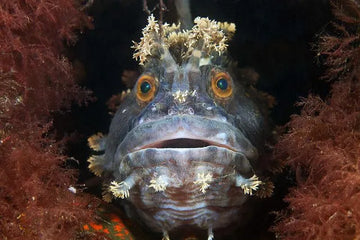No one thinks of Japan as an interesting place for diving. No one. Galapagos, Australia, Red Sea, Indonesia, Philippines, Baja California, Maldives... these are the destinations that many divers prefer for a good diving vacation. Have you ever heard anyone recommend Japan as a diving destination? I haven't.
Before we continue, did you know that we have an exclusive collection of diving t-shirts and sweatshirts for ocean lovers like you? Super comprehensive, made with organic cotton, and worldwide shipping.
 Pacific giant octopus on the coasts of Japan, photo by Alexander Semenov
Pacific giant octopus on the coasts of Japan, photo by Alexander SemenovAfter seeing several images by Alexander Semenov, a Russian biologist and one of my favorite underwater photographers, about the Sea of Japan, I discovered, with enormous surprise, that there are more than 2,000 diving spots in that country with enormous diversity. After all, it's an immense archipelago formed by almost 7,000 islands totaling 34,000 kilometers of coastlines. Additionally, in Japan, you can enjoy different underwater conditions without leaving the country, with subtropical areas and others near the Arctic... All things considered, in Japan, you can organize the most exotic vacations possible: both the surface and its underwater landscapes are unique and incomparable.
But... what do the depths surrounding Japan hide? In an archipelago of that size, bathed by both the Pacific and the Sea of Japan, the secrets are almost endless. Meda Point is one of the most appreciated places for diving in Japan with two main attractions: jellyfish and octopuses. But we're not talking about just any jellyfish or any octopus. In Japan, we can find the Cyanea capillata lion's mane jellyfish. It's the largest existing jellyfish, but it's also the "longest" animal on the planet: its tentacles can reach up to 70 meters.
 Youthful specimen of Cyanea capillata or lion's mane jellyfish, photo by Alexander Semenov
Youthful specimen of Cyanea capillata or lion's mane jellyfish, photo by Alexander SemenovAnother major attraction at Meda Point is the giant octopuses, capable of weighing 50 kg and feeding on sharks thanks to their huge beak-shaped mouth. These animals are not only extraordinary in size, but also in their intelligence and their ability to mimicry.
Pacific giant octopus hunting a shark
Another interesting area for diving in Japan is the Izu Peninsula, both for its proximity to Tokyo and being a confluence of both warm and cold waters. Its location allows fish from different latitudes to be found on its coast. In this area, you can visit interesting wrecks like the Shohan Maru, an 80-meter long cargo ship that sank 50 years ago and is teeming with corals, lionfish and highly venomous stonefish. Additionally, occasional sightings of whitetip sharks and some hammerhead sharks.
Japanese subtropical areas are also very interesting, both for their recent history and for the local fauna and flora. The Kerama Islands are 22 islands that served as preparation for the American army for the famous Battle of Okinawa, the World War II battle that left the most casualties, more than 250,000.
 Zamami Island, one of the 22 islands in the Kerama archipelago
Zamami Island, one of the 22 islands in the Kerama archipelago
These islands, which boast 76 diving spots, are lucky to host a great variety of corals, unique crustaceans, tropical fish such as clownfish, Picasso triggerfish, mandarin fish, or one of the most spectacular moray eels: the ribbon eel. Visitors can also enjoy sightings of some of the largest and most peaceful ocean creatures like humpback whales and giant manta rays, beautiful animals that can reach a wingspan of up to 6 meters.
The Mystery of Yonaguni
One of the major attractions for divers in Japan is Yonaguni Island. There, you can dive with large schools of hammerhead sharks, colorful hard and soft corals, various parrotfish, or the fastest of tunas... but that's not the most interesting thing about Yonaguni.
 Yonaguni Monument: Lost underwater city or rock formation?
Yonaguni Monument: Lost underwater city or rock formation? In 1986, a local diver, searching for sharks, discovered a rock formation that is still debated today whether it was created by humans or by nature. Known as the Yonaguni Monument, this formation, which can be visited from just 10 meters deep, has whimsical shapes that suggest it was a city submerged under the water over millennia, never known to have existed.
Access to this monument is through a wide entrance similar to a large corridor leading to huge perfectly sculpted steps over 40 meters long, reminiscent of pre-Columbian temples. Yonaguni has two especially mysterious areas: on one side, a space with a sculpted floor with distinct right angles that many claim to be a turtle. On the other side, you can dive around a formation resembling a monolithic pyramid, 25 meters tall. Those who argue it's a human-made site estimate that this city sank about 12,000 years ago... conflicting with those who think it's due to the frequent seismic activity in the area. Whether or not it's a case for Iker Jiménez, it's an extraordinary place for curious dives. Judge for yourselves:
The Mystery of Yonaguni
Perhaps after getting to know these diving spots in Japan, the next time someone starts a conversation about dream dive destinations, the treasures hidden in the Japanese depths might come to your mind.





















